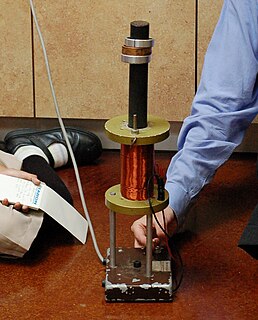
A linear motor is an electric motor that has had its stator and rotor "unrolled" so that instead of producing a torque (rotation) it produces a linear force along its length. However, linear motors are not necessarily straight. Characteristically, a linear motor's active section has ends, whereas more conventional motors are arranged as a continuous loop.

Transrapid is a German-developed high-speed monorail train using magnetic levitation. Planning for the Transrapid system started in 1969 with a test facility for the system in Emsland, Germany completed in 1987. In 1991 technical readiness for application was approved by the Deutsche Bundesbahn in cooperation with renowned universities.

A linear induction motor (LIM) is an alternating current (AC), asynchronous linear motor that works by the same general principles as other induction motors but is typically designed to directly produce motion in a straight line. Characteristically, linear induction motors have a finite primary or secondary length, which generates end-effects, whereas a conventional induction motor is arranged in an endless loop.

Electrodynamic suspension (EDS) is a form of magnetic levitation in which there are conductors which are exposed to time-varying magnetic fields. This induces eddy currents in the conductors that creates a repulsive magnetic field which holds the two objects apart.

Levitation is the process by which an object is held aloft, without mechanical support, in a stable position.
Electromagnetic propulsion (EMP), is the principle of accelerating an object by the utilization of a flowing electrical current and magnetic fields. The electrical current is used to either create an opposing magnetic field, or to charge a field, which can then be repelled. When a current flows through a conductor in a magnetic field, an electromagnetic force known as a Lorentz force, pushes the conductor in a direction perpendicular to the conductor and the magnetic field. This repulsing force is what causes propulsion in a system designed to take advantage of the phenomenon. The term electromagnetic propulsion (EMP) can be described by its individual components: electromagnetic – using electricity to create a magnetic field, and propulsion – the process of propelling something. When a fluid is employed as the moving conductor, the propulsion may be termed magnetohydrodynamic drive. One key difference between EMP and propulsion achieved by electric motors is that the electrical energy used for EMP is not used to produce rotational energy for motion; though both use magnetic fields and a flowing electrical current.
Inductrack is a passive, fail-safe electrodynamic magnetic levitation system, using only unpowered loops of wire in the track and permanent magnets on the vehicle to achieve magnetic levitation. The track can be in one of two configurations, a "ladder track" and a "laminated track". The ladder track is made of unpowered Litz wire cables, and the laminated track is made out of stacked copper or aluminium sheets.

The Shanghai Maglev Train or Shanghai Transrapid is a magnetic levitation train (maglev) line that operates in Shanghai. The line is the third commercially operated magnetic levitation line in history, after the British Birmingham Maglev and the German M-Bahn, and the first commercial high-speed maglev.
It is the fastest commercial high-speed electric train in the world.

Electromagnetic suspension (EMS) is the magnetic levitation of an object achieved by constantly altering the strength of a magnetic field produced by electromagnets using a feedback loop. In most cases the levitation effect is mostly due to permanent magnets as they don't have any power dissipation, with electromagnets only used to stabilize the effect.

The SCMaglev is a magnetic levitation (maglev) railway system developed by Central Japan Railway Company and the Railway Technical Research Institute.
A ground effect train is an alternative to a magnetic levitation (maglev) train. In both cases the objective is to prevent the vehicle from making contact with the ground. Whereas a maglev train accomplishes this through the use of magnetism, a ground effect train uses an air cushion; either in the manner of a hovercraft or using the "wing-in-ground" design.

Linimo , formally the Aichi High-Speed Transit Tobu Kyuryo Line is a magnetic levitation train line in Aichi Prefecture, Japan, near the city of Nagoya. While primarily built to serve the Expo 2005 fair site, the line now operates to serve the local community.
The Baltimore–Washington Superconducting Maglev Project is a proposal from the United States cities of Baltimore, Maryland, and Washington, D.C., to build a 39.8-mile (64.1 km) maglev train system between their respective central business districts. It is the first segment of the planned Washington-New York Northeast Maglev project.

skyTran is a Personal Rapid Transit system concept first proposed by inventor Douglas Malewicki in 1990, and under development by Unimodal Inc. A prototype of the skyTran vehicle and a section of track have been constructed. The early magnetic levitation system, Inductrack, now abandoned by skytran, has been tested by General Atomics with a full-scale model. In 2010 UniModal Inc. signed an agreement with NASA to test and develop skyTran. A skyTran system is being built in Israel as a pilot project. It was initially projected to be completed in Tel Aviv by the end of 2015. As of January 2016 work is ongoing with the test demonstration track. SkyTran has proposed additional projects in France, Germany, India, Indonesia, Malaysia, the United Kingdom, and the United States.
The National Maglev Initiative (NMI) was a research program undertaken in the early 1990s by the United States Department of Transportation, U.S. Army Corps of Engineers, Department of Energy, and other agencies which studied magnetically levitated, or "maglev", train technology, operating at speeds around 300 miles per hour (480 km/h). The effort was created in April 1990 and released a report in 1993. The Intermodal Surface Transportation Efficiency Act of 1991 (ISTEA) authorized $725 million in funds for maglev research, pending the results of the NMI study, but an appropriation of funds was also required, and it's not clear if that ever occurred.

The Incheon Airport Maglev is a maglev line in South Korea opened in February 3, 2016. It is the world's second commercially operating unmanned urban maglev line after Japan's Linimo. The trains are lighter, cutting construction costs in half. The majority of construction was completed by November 2012.
Hermann Kemper was a German engineer and pioneer in magnetic levitation.

The Changsha Maglev Express, is a medium-low speed magnetic levitation, or maglev line in Changsha, China. This is China's second maglev line, after Shanghai Maglev, and the first domestically built maglev line that uses indigenous technology. The line stretches over 18.55 kilometers and runs between Changsha Huanghua International Airport, Langli station and the high-speed railway station Changsha South railway station. Its rolling stock is designed for a speed of up to 120 km/h, currently however it is running with a maximum speed of 100 km/h.













